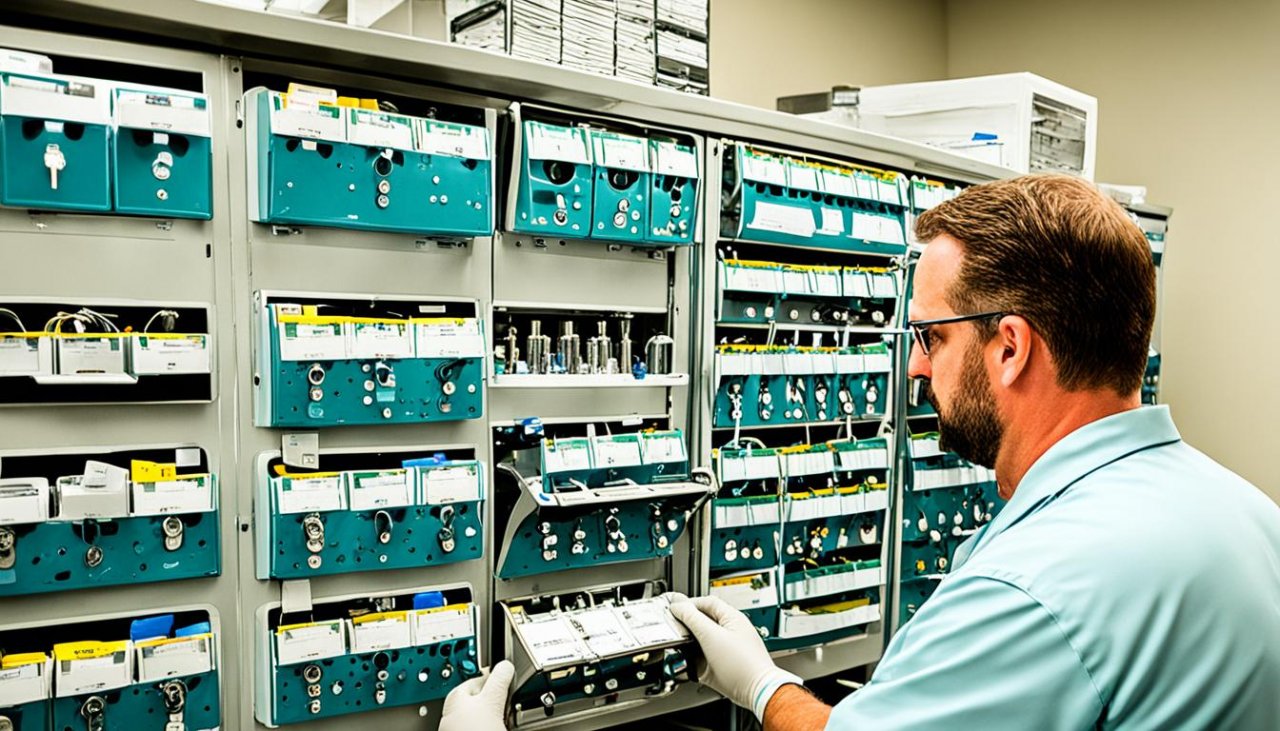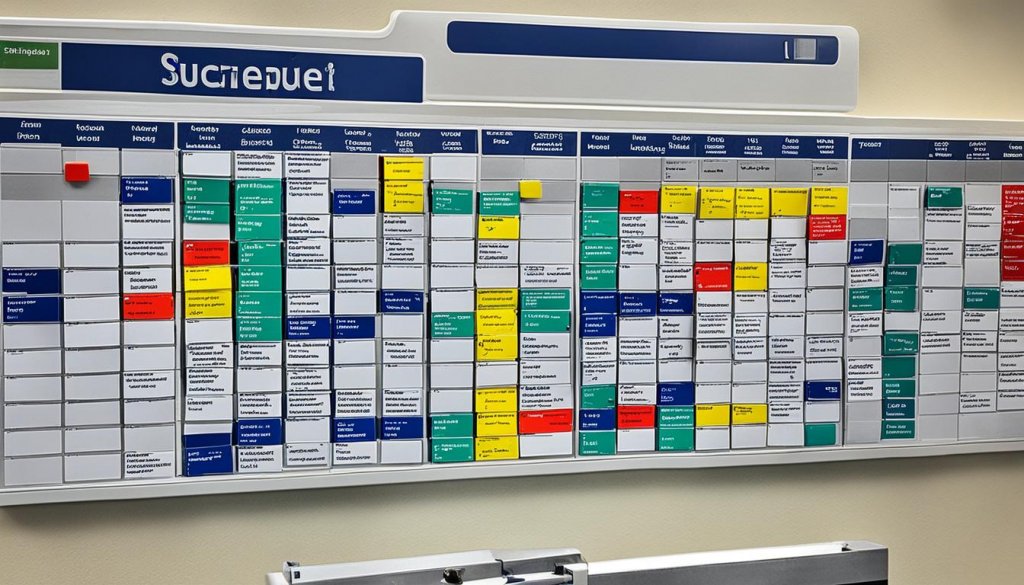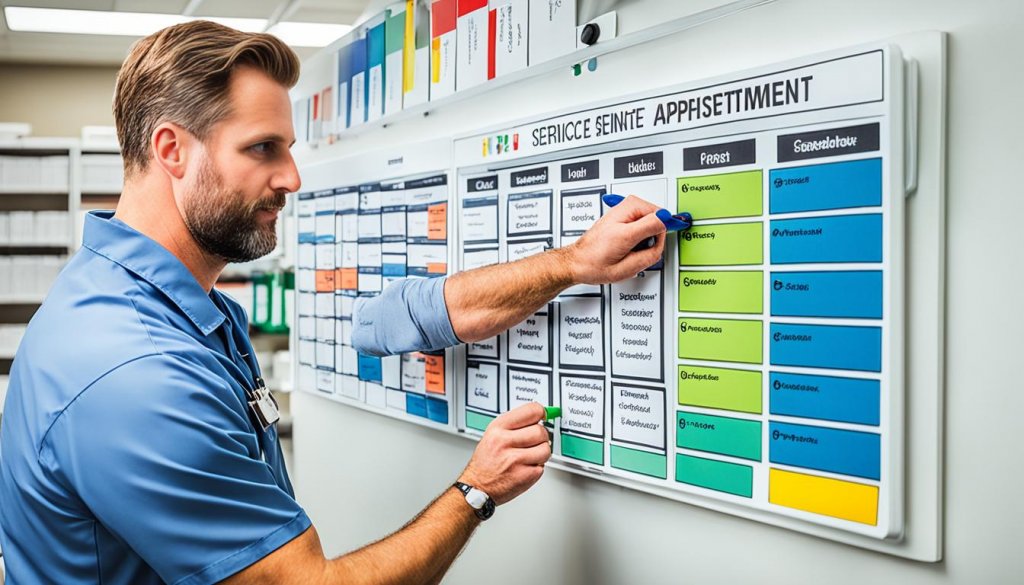Have you ever thought about how a simple scheduling tool can change medical equipment services? Efficient technician scheduling is key, not just a luxury. It’s crucial in today’s fast-paced healthcare world to make sure equipment is always ready for patients.
With new automated solutions and software, we can change how we manage equipment maintenance. This means less downtime and better care for patients.
Using modern scheduling lets us quickly get to customer info and equipment details. This means scheduling a service call in seconds, not minutes. It makes things faster and improves how customers feel.
Managing teams is easier with drag-and-drop tools and Google Maps for the best routes. This guide will show you how these tools make scheduling more efficient. Let’s dive into the key parts of scheduling that make a big difference.

Key Takeaways
- Immediate access to critical service information boosts efficiency.
- Scheduling can be completed quickly, improving response times.
- Automatic technician assignment enhances operational flow.
- Google Map integration leads to optimal route planning for technicians.
- Real-time monitoring increases productivity and job tracking.
- Companies can gain better insights into performance through integrated software.
- Enhanced customer service through automated reminders and tracking capabilities.
Understanding the Importance of Efficient Technician Scheduling
Efficient scheduling for medical equipment is key in healthcare. It helps use resources well and has big benefits. It cuts down wait times and makes sure patients get care when they need it.
A good scheduling system helps avoid missed appointments and makes sure devices are ready. It puts appointments in order by how urgent they are. This means patients get the care they need fast, making them happier and helping staff work better.
Using technology like automated waitlists and self-scheduling changes how appointments are handled. Automated messages help cut down on missed appointments. This is especially helpful for patients who find it hard to get to the clinic.
With a detailed scheduling process, we can handle equipment better and tackle unexpected problems. Regular maintenance of medical devices stops them from breaking down. I’ve seen that a good scheduling system is more than just a way to organize things. It’s a key part of giving better patient care and saving money over time.
Challenges in Technician Scheduling for Medical Equipment
Organizations often face big challenges in scheduling medical equipment technicians. Managing lots of appointments can get really tough, especially with last-minute cancellations. Finding enough staff and coordinating their schedules to meet patient needs is hard too. This can make everyone, including staff and patients, unhappy.
Not having good data management is a big problem. Without it, my team and I can’t handle the ups and downs in demand well. Studies show that better scheduling can make things run smoother. For example, the right scheduling can cut down on wait times and improve service in medical places.
Patient no-shows and late arrivals add to the challenge. Recent studies say using smart scheduling can help use resources better and make patients happier. I think making this process better is key to giving top-notch healthcare and making sure medical equipment works well.
Benefits of Streamlined Technician Scheduling
Streamlined technician scheduling makes medical equipment services run smoother. It cuts down on equipment downtime, making sure vital devices are ready for patients. This leads to better patient care by fixing equipment on time, avoiding treatment delays.
Using advanced scheduling software helps automate routine tasks. This makes the process smoother for both technicians and healthcare workers. It matches technicians with the right tasks based on their skills and when they’re free. This way, fixing medical equipment is planned better, sticking to maintenance schedules and cutting down on unexpected breakdowns.
With these systems, resources are used better. This helps doctors and health workers work together better. I’ve seen how coordinated care makes patients’ treatment smoother, which can lower costs for chronic diseases.
Streamlining technician scheduling also makes things easier for patients and staff. It helps healthcare systems make more money by keeping patients in one care network. This approach is a big win for everyone, from cutting down on follow-up visits to improving patient care.

Key Features of an Effective Scheduling System
An effective scheduling system is key for managing biomedical equipment services well. Automation cuts down on manual errors, making sure technicians get their tasks right away. Real-time updates keep everyone in the loop, helping healthcare places adjust fast to new demands.
Having mobile access is also key. Technicians in the field get a big boost from being able to check schedules on their devices anytime. This lets them plan their day better, making their work more efficient. Software that works well on mobile helps staff and management talk better.
Data analytics is crucial for checking how well things are doing. The system’s reporting tools let me see if services meet standards and how efficient they are. I can spot trends and areas that need work. Custom interfaces make it easy for everyone to use the system.
Being able to easily reschedule or cancel appointments is a must. It keeps patients coming back and makes their experience better. Using these features in a scheduling system makes things run smoother and improves healthcare efficiency.
Techniques to Improve Equipment Maintenance Scheduling
Improving equipment maintenance scheduling is key for healthcare facilities to work better. Using predictive maintenance helps plan when to check and fix medical equipment. By looking at past maintenance and following the maker’s advice, I can set the best maintenance times for each piece of equipment.
Condition-monitoring sensors give real-time info on how well equipment is working. This info lets me spot problems early, cutting down on costly fixes. Important equipment like baby incubators and life support machines get the care they need, keeping patients safe and equipment reliable.
Using a digital system to manage equipment makes scheduling easier. It helps avoid mistakes like buying the wrong spare parts. With Computerized Maintenance Management Systems (CMMS), my team can keep detailed maintenance records and set alerts for when things need checking. Regular maintenance checks make sure we meet standards and find any issues that might slow us down.
By being proactive and using digital tools, I can quickly fix problems when they happen. The best maintenance plan is 80% proactive, using preventive and predictive maintenance, and only 20% reactive. Using Enterprise Asset Management (EAM) software helps keep track of maintenance schedules and improves management.
Technician Scheduling Medical Equipment for Optimal Efficiency
Effective scheduling of medical equipment means the right technician is at the right place at the right time. This approach boosts efficiency and raises patient care levels. Using a technician dispatching system helps a lot. It lets us quickly move resources to where they’re needed most.
Calibration and regular maintenance are key in healthcare. Keeping medical equipment properly calibrated is crucial for accurate diagnoses and patient safety. A good scheduling plan helps with timely calibration and maintenance. This ensures devices work well and follow the maker’s guidelines.
When making a scheduling plan, we look at several things. We consider the equipment type, its importance to patient care, and the rules we must follow. This helps us create a plan that fits our facility’s needs and avoids downtime. A strong scheduling system and a good dispatch system improve workflow and healthcare results.

Utilizing Technician Assignment Software
Using technician assignment software can make managing healthcare equipment services much better. It gives a clear view of appointments and helps keep things organized. Features like drag-and-drop scheduling make it easy to fit different technician skills and job needs.
This software helps track how well things are going and makes sure everything follows the rules. For example, Resource Scheduling Optimization (RSO) saves a lot of time for dispatchers. This lets them focus on important tasks like billing, which makes things more efficient.
By fitting more appointments into the day, technicians work better and make more money. This also cuts down on overtime costs. The software matches technicians with jobs based on their skills, which means fewer lost appointments and less money lost.
Also, it cuts down on travel time, which means less fuel used and less money spent on car upkeep.
Plus, scheduling better means happier customers because they know when to expect things. Using tools like Deputy’s scheduling app makes talking to technicians easier. It sends them new work orders fast. This means they can order parts right away, keeping medical equipment running smoothly.
Adding subcontractors and vendors with this software helps finish work orders faster. Using a scheduling system for healthcare equipment is key. It improves service, keeps customers happy, and helps keep more money coming in for healthcare services.
Implementing Automated Equipment Service Scheduling
Automating how we schedule equipment service has changed the game. It cuts down on manual errors and speeds up the process. Now, I can easily keep track of equipment service history, plan maintenance, and assign technicians with ease.
This shift brings more than just speed. It makes sure we meet industry standards, which helps patients get the best care. Losing medical equipment is a big deal, costing hospitals a lot of money. So, using automated systems is key to keeping things running smoothly.
Using cloud-based software gives me instant updates on equipment and schedules. This tech makes things run smoother, cuts down on mistakes, and saves time. Plus, tools like Microsoft Dynamics 365 Field Service help us use our resources better. This means less time traveling and more time working, making our team more efficient.
Optimizing Medical Equipment Repair Scheduling
Getting medical equipment fixed quickly is key in healthcare. We make sure to fix things based on how urgent they are and how they affect patient care. By looking at past repairs, we can guess what we’ll need in the future. This way, we keep our equipment running smoothly with less downtime.
January is a great time to check and improve our maintenance plans for medical equipment. Looking ahead lets us make changes that make a big difference. It’s important to keep checking our maintenance dates to avoid problems with equipment not being ready.
Big networks should often check if they have enough resources for now and the future, especially when adding new equipment. Planning for things like calibration services saves money and helps in negotiating contracts. It’s also key to make sure our team has enough people and to match shipment schedules with maintenance plans.
It’s important to plan maintenance when there’s less work in the healthcare sector. This approach reduces disruptions and improves patient care and relationships. For example, we know ultrasound machines need replacing every 5-7 years and X-ray machines last 10-14 years. So, we plan maintenance before they break down to cut down on unexpected downtime.
Replacing machines when repair costs get too high in the last two years makes sense. I focus on not wasting time on cosmetic fixes for machines that will soon be replaced. Good maintenance programs can make equipment last longer and fail less often.
Predictive maintenance helps us handle sudden equipment failures better, which saves money on emergency repairs and downtime. Facilities that follow these strategies see more money coming in and happier patients. As medical equipment gets more complex, using scheduling solutions for biomedical equipment is key to running smoothly.
Techniques for Effective Technician Dispatching System
An effective technician dispatching system boosts the performance of medical equipment services. By using geographical mapping and real-time tracking, I make sure technicians get to their destinations efficiently. This helps solve problems like tight deadlines and the stress of poor route planning.
One key technique is matching technicians with the right skills for the job. This makes customers happier. I start workdays with easy tasks to keep things running smoothly. Also, focusing on urgent tasks first helps technicians finish jobs on time.
Automation and tracking software change the game for scheduling medical equipment. These tools improve communication with technicians and make handling emergencies easier. By keeping an eye on performance and listening to patient feedback, I can always make the dispatch process better.
When I hire new dispatchers, I look for their ability to multitask and solve problems. Knowing how to use dispatching software is crucial for making good decisions and running smoothly. A great technician dispatching system saves time and money, making customers happier. Investing in technology and smart scheduling tools can lead to growth and better service quality.
Conclusion
Improving how we schedule technicians for medical equipment is key to better healthcare. Using new methods and tech brings many benefits. It cuts down on equipment downtime and makes patients happier and operations smoother.
Looking back, managing medical equipment well is crucial. In places like Ethiopia, over 30% of medical gear doesn’t work, showing the need for good scheduling. By using data to plan, I can help improve healthcare for everyone.
Investing in strong scheduling tools is important for timely and quality care. Studies show that better scheduling helps with managing equipment and keeps patients safe. By focusing on efficiency and new ideas, I’m ready for the changing healthcare world.
See how FieldAx can transform your Field Operations.
Try it today! Book Demo
You are one click away from your customized FieldAx Demo!
FAQ
What is technician scheduling for medical equipment?
Technician scheduling for medical equipment means planning who fixes and maintains medical devices. It makes sure devices get checked on time. This cuts down on downtime and helps patient care.
Why is efficient technician scheduling important in healthcare?
It’s key because it helps with work flow, makes patients happy, and keeps care quality high. By making things run smoother, hospitals can cut wait times. This means better care for everyone.
What challenges do organizations face with technician scheduling?
Groups face big appointment loads, last-minute cancellations, and finding techs when needed. These problems cause delays and make patients unhappy, hurting care quality.
How can streamlined technician scheduling benefit healthcare facilities?
It makes things run better, cuts down on device downtime, and helps care for patients. Using new scheduling tools helps automate tasks and match techs with jobs well, ensuring quick service.
What features should I look for in an effective scheduling system?
Look for automation, data analysis, updates in real time, tech access on the go, and many ways to communicate. These features cut down on mistakes and make things more flexible.
How can healthcare facilities improve equipment maintenance scheduling?
Improve it by using predictive maintenance, setting up auto reminders, and looking at past data to plan for the future.
What role does technician dispatching play in equipment scheduling?
It helps quickly move resources around based on what’s needed right now. This makes sure the right tech goes to the right equipment fast, making things run smoothly.
How can technician assignment software help streamline the scheduling process?
This software makes scheduling easier with drag-and-drop tools and automated work orders. It gives a clear view of where techs are and what they’re doing.
What advantages does automating equipment service scheduling offer?
Automating it cuts down on mistakes and delays by keeping track of service history, sending out alerts, and managing tech assignments well. This makes services ready and follows rules better.
What steps can be taken to optimize medical equipment repair scheduling?
Focus on fixing urgent issues first by looking at past problems. This ensures quick fixes and keeps equipment working right.
What features are important for an effective technician dispatching system?
A good system needs to use maps, track in real time, and match tech skills to jobs. This makes field service better and keeps clients happy.
Author Bio
Co-Founder & CMO at Merfantz Technologies Pvt Ltd | Marketing Manager for FieldAx Field Service Software | Salesforce All-Star Ranger and Community Contributor | Salesforce Content Creation for Knowledge Sharing





